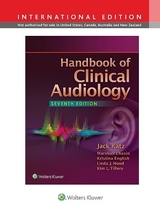
Handbook of Clinical Audiology
Lippincott Williams and Wilkins (Verlag)
978-1-4511-0717-3 (ISBN)
- Keine Verlagsinformationen verfügbar
- Artikel merken
For more than 35 years, students and audiologists have turned to the acclaimed Handbook of Clinical Audiology to master the principles and methods of the field. This text and reference offers scientific, clinical, and philosophical insights regarding current issues and procedures in audiology. This new edition incorporates the most recent material in the physiology, assessment, diagnosis, and management of hearing disorders. It is a readable, thorough compendium of hearing procedures and information, interpreted by highly respected individuals in the field.
Dedication Foreword by Moe Bergman Preface Contributors Section I: Introduction and Basic Tests and Procedures Chapter 1: Clinical Audiology Chapter 2: Calibration: Puretone, Speech, and Noise Signals Chapter 3: Puretone Evaluation Chapter 4: Assessing Bone Conduction Thresholds in Clinical Practice Chapter 5: Speech Audiometry Chapter 6: Clinical Masking Chapter 7: Case History Section II: Physiological Principles and Measures Chapter 8: Principles of Acoustic Immittance and Acoustic Transfer Functions Chapter 9: Tympanometry in Clinical Practice Chapter 10: The Acoustic Reflex Chapter 11: Introduction to Auditory Evoked Potentials Chapter 12: Electrocochleography Chapter 13: Auditory Brainstem Response: Differential Diagnosis Chapter 14: Auditory Brainstem Response in Threshold Prediction Chapter 15: The Auditory Steady-State Response Chapter 16: Intraoperative Neurophysiology Monitoring of Auditory Evoked Potentials Chapter 17: Middle Latency Auditory Evoked Potentials: Update Chapter 18: Cortical Event-Related Potentials to Auditory Stimuli Chapter 19: Clinical Neurophysiology of the Vestibular System Chapter 20: Evaluation of the Patient with Dizziness and Balance Disorders Chapter 21: Otoacoustic Emissions Chapter 22: Current Physiologic Bases of Audiologic Interpretation and Management Section III: Special Populations Chapter 23: Assessment of Hearing Loss in Children Chapter 24: Educational Audiology Chapter 25: Mechanisms Underlying Central Auditory Processing Chapter 26: Auditory Pathway Representation of Speech Sounds in Humans Chapter 27: Central Auditory Processing Evaluation: A Test Battery Approach Chapter 28: Management of Central Auditory Processing Disorders Chapter 29: Individuals with Multiple Disabilities Chapter 30: Noise Exposure and Issues in Hearing Conversation Chapter 31: Nonorganic Hearing Loss Chapter 32: Hearing Loss in the Elderly: A New Look at an Old Problem Chapter 33: Tinnitus and Hyperacusis Section IV: Management of Hearing Disorders Chapter 34: Room Acoustics and Auditory Rehabilitative Technology Chapter 35: Hearing Aid Technology Chapter 36: Troubleshooting Hearing Aids Chapter 37: Hearing Instrument Fitting and Verification for Children Chapter 38: Hearing Aid Fitting for Adults: Selection, Fitting, Verification, and Validation Chapter 39: Building and Growing a Successful Audiology Practice Chapter 40: Cochlear Implants Chapter 41: Intervention, Education, and Therapy for Children Who Are Deaf or Hard of Hearing Chapter 42: Management of Adults with Hearing Loss Chapter 43: Counseling: How Audiologists Can Help Patients Adjust to Hearing Loss Author Index Subject Index
| Erscheint lt. Verlag | 1.7.2010 |
|---|---|
| Mitarbeit |
Chef-Herausgeber: Jack Katz |
| Verlagsort | Philadelphia |
| Sprache | englisch |
| Maße | 213 x 277 mm |
| Gewicht | 2383 g |
| Themenwelt | Medizin / Pharmazie ► Gesundheitsfachberufe ► Logopädie |
| ISBN-10 | 1-4511-0717-X / 145110717X |
| ISBN-13 | 978-1-4511-0717-3 / 9781451107173 |
| Zustand | Neuware |
| Haben Sie eine Frage zum Produkt? |
aus dem Bereich



